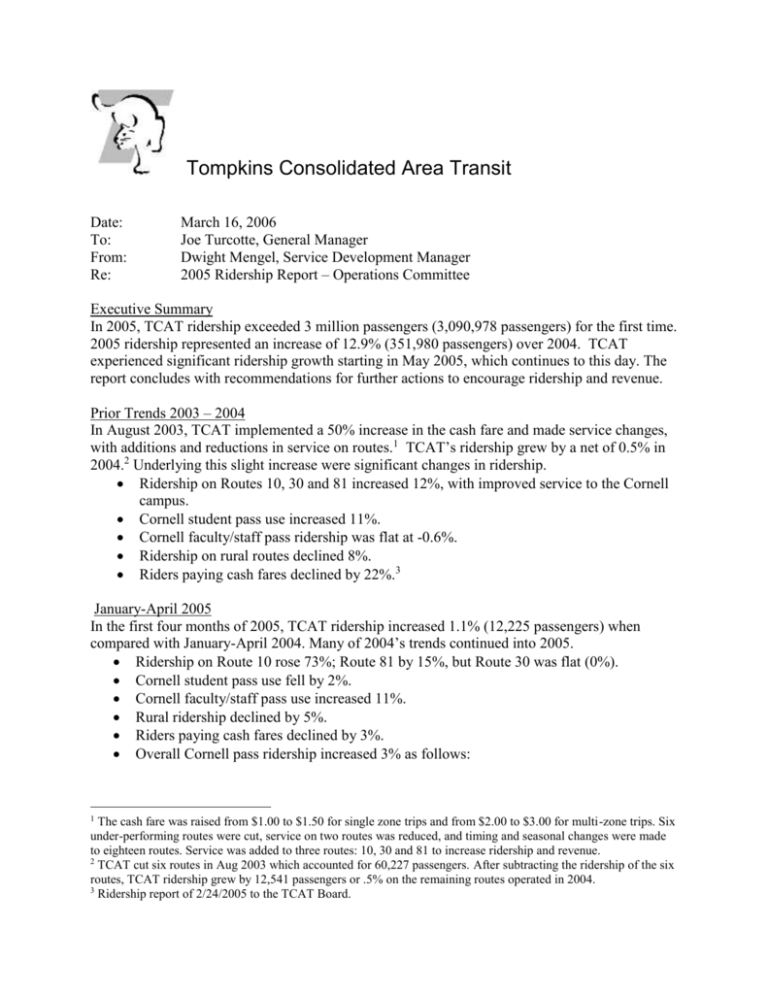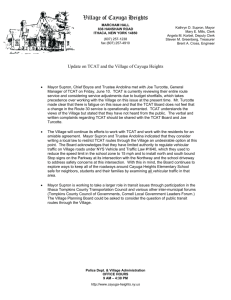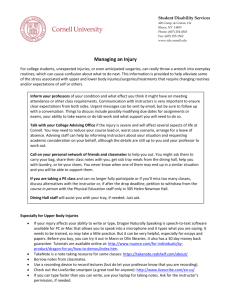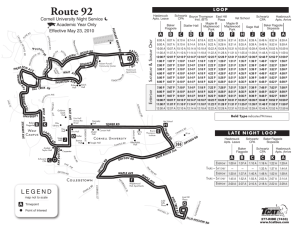File - Tompkins Co. Public Transit Archive
advertisement

Tompkins Consolidated Area Transit Date: To: From: Re: March 16, 2006 Joe Turcotte, General Manager Dwight Mengel, Service Development Manager 2005 Ridership Report – Operations Committee Executive Summary In 2005, TCAT ridership exceeded 3 million passengers (3,090,978 passengers) for the first time. 2005 ridership represented an increase of 12.9% (351,980 passengers) over 2004. TCAT experienced significant ridership growth starting in May 2005, which continues to this day. The report concludes with recommendations for further actions to encourage ridership and revenue. Prior Trends 2003 – 2004 In August 2003, TCAT implemented a 50% increase in the cash fare and made service changes, with additions and reductions in service on routes.1 TCAT’s ridership grew by a net of 0.5% in 2004.2 Underlying this slight increase were significant changes in ridership. Ridership on Routes 10, 30 and 81 increased 12%, with improved service to the Cornell campus. Cornell student pass use increased 11%. Cornell faculty/staff pass ridership was flat at -0.6%. Ridership on rural routes declined 8%. Riders paying cash fares declined by 22%.3 January-April 2005 In the first four months of 2005, TCAT ridership increased 1.1% (12,225 passengers) when compared with January-April 2004. Many of 2004’s trends continued into 2005. Ridership on Route 10 rose 73%; Route 81 by 15%, but Route 30 was flat (0%). Cornell student pass use fell by 2%. Cornell faculty/staff pass use increased 11%. Rural ridership declined by 5%. Riders paying cash fares declined by 3%. Overall Cornell pass ridership increased 3% as follows: 1 The cash fare was raised from $1.00 to $1.50 for single zone trips and from $2.00 to $3.00 for multi-zone trips. Six under-performing routes were cut, service on two routes was reduced, and timing and seasonal changes were made to eighteen routes. Service was added to three routes: 10, 30 and 81 to increase ridership and revenue. 2 TCAT cut six routes in Aug 2003 which accounted for 60,227 passengers. After subtracting the ridership of the six routes, TCAT ridership grew by 12,541 passengers or .5% on the remaining routes operated in 2004. 3 Ridership report of 2/24/2005 to the TCAT Board. Jan-Apr Cornell Pass Ridership, 2005 vs. 2004 CU Student CU Staff CU Total 2005 492,262 335,349 827,611 2004 504,770 301,964 806,734 Difference (12,508) 33,385 20,877 Percent Change -2% 11% 3% The largest increase in CU staff was in OMNI single zone riders which grew by 26% or 27,874 passengers. The significant growth in OMNI single zone ridership is a key underlying trend propelling ridership growth from May 2005 onward. TCAT Monthly Ridership: 12 Month Moving Average Sept 2003 - Feb 2006 Se p0 D 3 ec -0 M 3 ar -0 Ju 4 n0 Se 4 p0 D 4 ec -0 M 4 ar -0 Ju 5 n0 Se 5 p0 D 5 ec -0 5 270,000 260,000 250,000 240,000 230,000 220,000 210,000 200,000 TCAT’s ridership is cyclical over a year and variable from month to month. A 12-month moving average is useful to identify past trends. From September 2003 to May 2005, TCAT’s 12-month average ridership hovered around 230,000 passengers a month. From September 2004 until May 2005, the average was trending below 230,000. Beginning in May 2005 and continuing afterwards TCAT’s significant ridership growth is apparent. May 2005 Ridership Growth From May – July 2005, TCAT ridership increased 16% (74,926 passengers) over 2004. There was a broad base ridership increase with 22 routes gaining riders while 12 routes lost riders. Eighty-seven percent of the increase (65,186 passengers) was on routes: 10, 30, 81, and 93.4 4 Route May-July 2005 May-July 2004 Percent Change Difference 10 45,209 23,573 21,636 92% 30 135,272 122,932 12,340 10% 81 106,247 80,082 26,165 33% 93 8,536 3,491 5,045 145% Total 295,264 230,078 65,186 28% In May 2005, the TCAT Board authorized the Route 93 Blue Light route to continue to operate during the summer in response to an advocacy campaign from Route 93 riders. In 2005, Rt 93 ridership increased to 60,107 passengers, a 35% from 2004. So, before Hurricane Katrina in late August and $3.63/gallon gasoline in September, TCAT was on a trend of high ridership growth beginning in May and continuing through the summer. The key to the ridership growth was the 19% increase in Cornell pass riders, (CU staff riders 25% and CU Students 12%) as shown in the table below. May-July Cornell Pass Ridership, 2005 vs. 2004 2005 2004 Difference CU Student 163,067 145,391 17,676 % Change 12% CU Staff 206,892 165,480 41,412 25% CU Total 369,959 310,871 59,088 19% Seventy-eight percent of the total increase in TCAT ridership (74,926) from May-July were participants of the Cornell pass program (59,088). “A Perfect Storm” – Two weeks In August 2005, TCAT ridership increased 20%. The start of the Fall 2005 semester saw the impact of both Cornell distributing over 5,000 free student passes (from the Redbud Wood’s settlement) and rapid gasoline price escalation after Hurricane Katrina. The immediate aftermath of these factors was an explosion in TCAT ridership by Cornell staff (up 64%) and students (up 47%). In the short two-week period of August 22 to September 5, 2005, Cornell pass ridership increased 53% when compared with 2004. Many TCAT buses on urban routes serving the campus were filled to capacity. In some instances bus operators had no choice but to turn away people waiting for a bus. TCAT did not have extra buses available to provide relief. This experience alerts TCAT to the need for contingency planning and keeping a small contingency fleet. While TCAT accommodated much of the surge in ridership, it did not have spare capacity to meet all of the new demand on existing routes. Comparison of Cornell University Ridership on all TCAT Routes 8/22 to 9/5 2004 and 8/21 to 9/4/2005 2005 2004 Difference CU Student CU OMNI CU ID SZ CU Staff Subtotal CU Pass Total 66,968 28,414 21,847 50,261 117,229 45,682 13,755 16,951 30,706 76,388 21,286 14,659 4,896 19,555 40,841 % Change 47% 107% 29% 64% 53% The top ten routes with the highest increase in passengers during this two week period were all urban routes. Route 30 81 10 17 82 2004 17,145 18,506 5,819 336 4,463 2005 28,764 29,604 8,727 2,950 6,520 Difference 11,619 11,098 2,908 2,614 2,057 % Change 68% 60% 50% 778% 46% Route 32 93 31 51 50 2004 3,819 2,044 3,319 1,583 2,460 2005 5,781 3,388 4,435 2,595 3,366 % Change 51% 66% 34% 64% 37% Difference 1,962 1,344 1,116 1,012 906 Bus ridership continued to increase in September as TCAT set a new monthly record by carrying 354,266 passengers, a 34.1% increase over September 2004. The question for TCAT was how ridership would change after gas prices declined and the surge was over. August 2005 to February 2006 Ridership exceeded 2004 levels for every month since August. A comparison of ridership for August to February is as follows: TCAT Bus Ridership August – February 2004/05 vs. 2005/06 Aug Sept Oct Nov Dec Jan Feb 2005/06 241,700 354,965 337,326 318,835 204,872 224,010 333,851 2,015,559 2004/05 201,925 264,095 292,554 242,406 192,293 203,027 275,005 1,671,305 Difference 39,775 90,870 44,772 76,429 12,579 20,983 58,846 344,254 Percent 20% 34% 15% 32% 7% 10% 21% 21% Overall TCAT ridership during the period grew by 21%. The ridership increase in January and February 2006 is particularly encouraging. This winter is relatively warm with little snow and gasoline prices fell $1.15/gallon from their peak in September. Clearly, TCAT is retaining a large number of customers who began riding the bus early in the fall. Cornell Pass Ridership on TCAT Operated Routes for Aug to Feb 2004/05 and 2005/065 CU Student CU Staff CU Total Aug-Feb 2005/06 1,072,632 823,211 1,895,843 Aug-Feb 2004/05 906,806 646,456 1,553,262 Difference 165,826 176,755 342,581 % Change 18% 27% 22% The actual and percent change increase in Cornell faculty/staff passengers exceeded student pass use. Cornell pass riders increased to 76% of total TCAT ridership during the period. 5 This table does not include ridership data for Tioga Transport operated routes. The table will be revised in the future. Tioga Transport operates routes 36, 37, 52, 53, 60 & 65. Ridership trends for August to February are: Ridership on Routes 10, 30 and 81 increased by 214,238 (26%) to 1,038,794. Twenty-six routes increased ridership while nine routes lost ridership. Urban routes increased 21% during the period. Rural routes increased 17%. Cornell student pass use increased 18%. Cornell faculty/staff pass ridership increased 27%. While the number of cash fare riders increased by 1% (1,601 riders) , the percent of cash fare riders of total TCAT ridership fell from 14% to 12% during the period. Conclusions 2005 was a very special year for TCAT. Ridership exceeded 3 million for the first time. Gasoline prices rose throughout the first eight months and surged above $3.60/gallon in September. Cornell faculty/staff ridership steadily increased through the year and was an important source of new or returning riders. The student ridership rose during the summer months and surged after August. High ridership growth is continuing into 2006. In January and February 2006, TCAT passengers grew by 16.7% when compared with 2005. Both urban and rural routes grew at similar rates of 16.7% and 16.4%. Recommendations Cash fares TCAT really needs to seriously consider the purpose of its cash fares. Having a multi-zone fare of twice the single zone fare is extremely rare in the transit industry. This is a legacy of the County’s former TOMTRAN fare system, which at this point in time has discouraged growth in multi-zone (rural) ridership. Many systems have a zone charge of $.50 added on the single zone fare. In 2005, there was discussion of a fare “sale” and temporarily discounting or eliminating the multi-zone fare. There is also interest in reducing the youth fare to encourage and enable more youth to ride the bus. Both issues are worthy of resolution. Passes The Monthly Pass has captured 6% of TCAT’s ridership. In 2003, staff proposed the Monthly (30 Day) Pass would be a very strong product, especially after its cost was set at $45 good for all zones. This pass needs to be more flexible. It could be programmed to work for 30 nonconsecutive days and be more attractive to regular users whose travel needs are not daily (e.g. community college students, part time employees, etc). Ithaca College and Tompkins Cortland Community College Both IC and TC3 have requested TCAT to work with them to encourage more bus riders to their campuses. Ridership on Route 11 (South Hill) has declined every month since August 2003. This route and the IC market need our attention. Route & Service Changes A number of route and service changes can be investigated for fall implementation including: Revising the 31 & 32, as per the NEST study, to terminate both routes at Pyramid Mall and increase weekend service. Add weekend service on Route 10 and link to an express shuttle between the Commons and Southwest Park retail stores. Add service to Wal-mart on Sunday. There are many worthy ideas for service changes to explore grow ridership, especially in the offpeak weekday period. TCAT has a unique opportunity build on the success of the past year and to expand and improve services in 2006. Car Sharing Ithaca’s car sharing initiative is another unique opportunity for TCAT to consider how it can be involved. A sustainable car-sharing program would enable more people to ride TCAT while have a short term car rental car for personal transportation needs. TCAT Ridership Data CU - Commons IC - Commons IC - CU Night Northside-Pryamid West Hill Southside Fall Creek Fall Creek Hospital Enfield Trumansburg Annual 2005 240,246 94,661 26,795 46,568 57,142 51,778 20,784 40,838 9,844 15,056 91,666 Annual 2004 152,455 96,113 31,949 50,684 60,941 44,374 20,168 18,407 9,360 15,681 86,536 Difference 87,791 -1,452 -5,154 -4,116 -3,799 7,404 616 22,431 484 -625 5,130 Percent 57.6% -1.5% -16.1% -8.1% -6.2% 16.7% 3.1% 121.9% 5.2% -4.0% 5.9% Taughannock Falls SP Summer Cass Park Summer Commons- Pyramid Airport - Northeast Pyramid-Northeast South Lansing North Lansing Groton Dryden-TC3 Groton Weekend Dryden Weekend Eastern Heights East Hill Plaza Newark Valley - Caroline Ellis Hollow Coddington Road Danby Newfield Cornell Campus Weekday Cornell Campus Weekday Cornell Campus Weekday Cornell Campus Weekday Cornell Campus Weekday Cornell Campus Wekend Cornell Campus Night Cornell Campus Night 9,430 5,587 696,222 121,468 129,798 9,070 20,179 27,061 94,963 2,173 3,230 82,460 78,077 40,705 5,286 750 9,591 33,098 14,275 635,947 150,720 59,022 47,906 4,538 53,745 60,107 3,116 7,241 628,338 119,591 122,769 9,755 19,283 24,425 92,327 1,467 2,395 71,463 67,567 36,256 5,383 1,443 8,068 29,179 16,057 507,233 151,536 61,057 58,318 5,588 51,818 44,524 6,314 -1,654 67,884 1,877 7,029 -685 896 2,636 2,636 706 835 10,997 10,510 4,449 -97 -693 1,523 3,919 -1,782 128,714 -816 -2,035 -10,412 -1,050 1,927 15,583 202.6% -22.8% 10.8% 1.6% 5.7% -7.0% 4.6% 10.8% 2.9% 48.1% 34.9% 15.4% 15.6% 12.3% -1.8% -48.0% 18.9% 13.4% -11.1% 25.4% -0.5% -3.3% -17.9% -18.8% 3.7% 35.0% 3,090,574 2,738,998 351,576 12.8% 3/16/2006 Route Type Urban Urban Urban Urban Urban Urban Urban Urban Urban Rural Rural Rural Urban Urban Urban Urban Rural Rural Rural Rural Rural Rural Urban Urban Rural Rural Rural Rural Rural Urban Urban Urban Urban Urban Urban Urban Urban Total TCAT Operator TCAT TCAT TCAT TCAT TCAT TCAT TCAT TCAT TCAT TCAT TCAT TCAT TCAT TCAT TCAT TCAT Tioga Tioga TCAT TCAT/Tioga TCAT TCAT TCAT TCAT Tioga Tioga Tioga Tioga TCAT TCAT TCAT TCAT TCAT TCAT TCAT TCAT TCAT Route 10 11 12 13 14 15 16 17 19 20 21 22 23 30 31 32 36 37 40 41/43 44 45 50 51 52 53 60 65 67 80 81 82 83 84 85 92 93 Name Routes 90s Total 80s Total Campus Urban Other Urban Total Urban Total Rural Routes 2005 113,852 912,409 1,026,261 1,702,266 2,728,527 362,258 2004 96,342 805,922 902,264 1,501,420 2,403,684 335,314 Difference 17,510 106,487 123,997 200,846 324,843 26,944 Percent 18.2% 13.2% 13.7% 13.4% 13.5% 8.0% Rural Large Market Rural Minimum Service Rural Total see below 260,432 244,298 16,134 6.6% see below 101,826 362,258 91,016 335,314 10,810 26,944 11.9% 8.0% 3,090,978 2,738,998 351,980 12.9% 90s Total 80s Total 80s + 90s see below TOTAL Ridership Other Urban Routes: 10,11,12,13,14,15,16,17,19,30,31,32,50,51 Rural Large Market Rural Minimum Service Routes: 21, 41/43,52,67 Routes: 20,22, 36,37,40,44,45, 53,60,65



